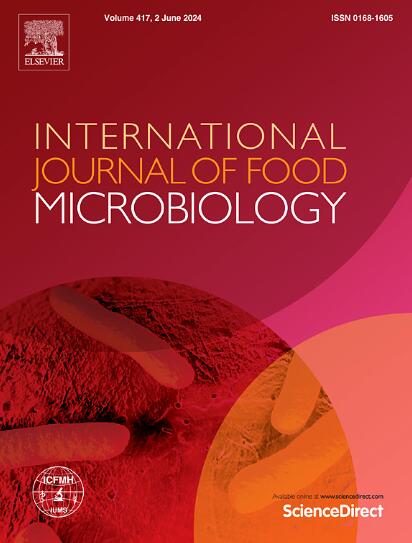Antibacterial activity and mechanism of novel phage endolysin lysSEP21 against dual-species biofilm of Salmonella and Escherichia coli and its application in food preservation
IF 5
1区 农林科学
Q1 FOOD SCIENCE & TECHNOLOGY
International journal of food microbiology
Pub Date : 2025-07-02
DOI:10.1016/j.ijfoodmicro.2025.111337
引用次数: 0
Abstract
Biofilms of Salmonella and Escherichia coli promote drug resistance and pathogenicity, as their multi-lipid structures hinder the eradication of these bacteria. Phage lytic proteins provide viable treatment strategies to eradicate biofilms. In this context, the antibiofilm efficacy of phage endolysin lysSEP21 was investigated against both species. Results of antibacterial activity showed the potent minimum inhibitory concentration (MIC) of ≤0.025 mg/mL, resulting in substantial 80 % lytic effects against Gram-negative and Gram-positive strains. The membrane disruption mechanism was further confirmed with increased release of β-lactamase and β-galactosidase from periplasm and cytosol, indicating effective degradation of outer and inner membranes (OM, IM), respectively. Furthermore, larger reductions up to 3.68 log10 CFU/mL were quantified in 1 h treated groups, leading to a ≥ 90 % reduction in biofilm-mass after 6 h. The viability of 36–42 h mature biofilm eradication was assessed by confocal laser scanning microscopy (CLSM) in a dead/live cell staining. Importantly, quantitative real-time PCR (qRT-PCR) analysis demonstrated that lysSEP21 significantly suppressed the relative gene expressions of key biofilm-regulating and virulence genes in Salmonella and E. coli. Moreover, this endolysin exhibited robust MDR Salmonella inhibition across food matrices, with reductions between 0.93 and 3.12 log10 CFU/mL. Altogether, lysSEP21 efficiently degraded mature biofilms and decontaminated food surfaces. Its application represents a remarkable advancement in food safety interventions and provides an exceptional strategy to mitigate public health risks associated with Salmonella and E. coli biofilms.
新型噬菌体内溶素lysSEP21对沙门氏菌和大肠杆菌双种生物膜的抑菌活性、抑菌机理及其在食品保鲜中的应用
沙门氏菌和大肠杆菌的生物膜促进耐药性和致病性,因为它们的多脂质结构阻碍了这些细菌的根除。噬菌体裂解蛋白为根除生物膜提供了可行的治疗策略。在此背景下,研究了噬菌体内溶素lysSEP21对这两种菌种的抗菌效果。结果表明,该菌的最低抑菌浓度(MIC)≤0.025 mg/mL,对革兰氏阴性菌和革兰氏阳性菌均有80%的抑菌效果。β-内酰胺酶和β-半乳糖苷酶从周质和细胞质中释放增加,进一步证实了膜破坏机制,表明外膜和内膜(OM, IM)分别有效降解。此外,在处理1 h的组中,定量减少了3.68 log10 CFU/mL,导致6 h后生物膜质量减少≥90%。通过共聚焦激光扫描显微镜(CLSM)在死/活细胞染色中评估36-42 h成熟生物膜根除的活力。重要的是,定量实时PCR (qRT-PCR)分析表明,lysSEP21显著抑制沙门氏菌和大肠杆菌中关键生物膜调控基因和毒力基因的相关基因表达。此外,该内溶素在食物基质中表现出强大的耐多药沙门氏菌抑制作用,降低幅度在0.93至3.12 log10 CFU/mL之间。总之,lysSEP21有效地降解了成熟的生物膜和净化了食物表面。它的应用代表了食品安全干预措施的显著进步,并提供了一种特殊的策略,以减轻与沙门氏菌和大肠杆菌生物膜相关的公共卫生风险。
本文章由计算机程序翻译,如有差异,请以英文原文为准。
求助全文
约1分钟内获得全文
求助全文
来源期刊
CiteScore
10.40
自引率
5.60%
发文量
322
审稿时长
65 days
期刊介绍:
The International Journal of Food Microbiology publishes papers dealing with all aspects of food microbiology. Articles must present information that is novel, has high impact and interest, and is of high scientific quality. They should provide scientific or technological advancement in the specific field of interest of the journal and enhance its strong international reputation. Preliminary or confirmatory results as well as contributions not strictly related to food microbiology will not be considered for publication.

 求助内容:
求助内容: 应助结果提醒方式:
应助结果提醒方式:


